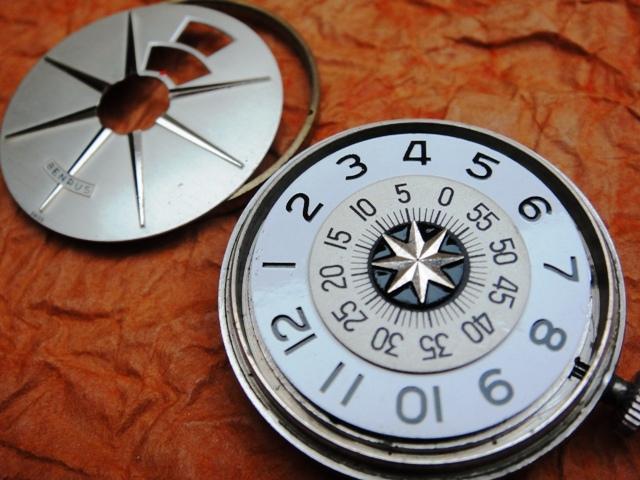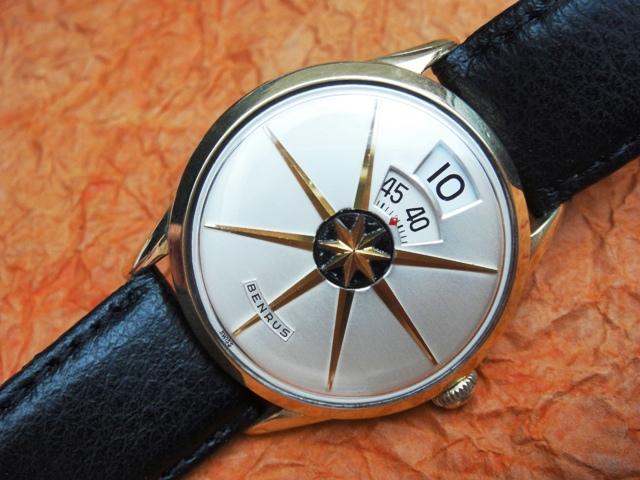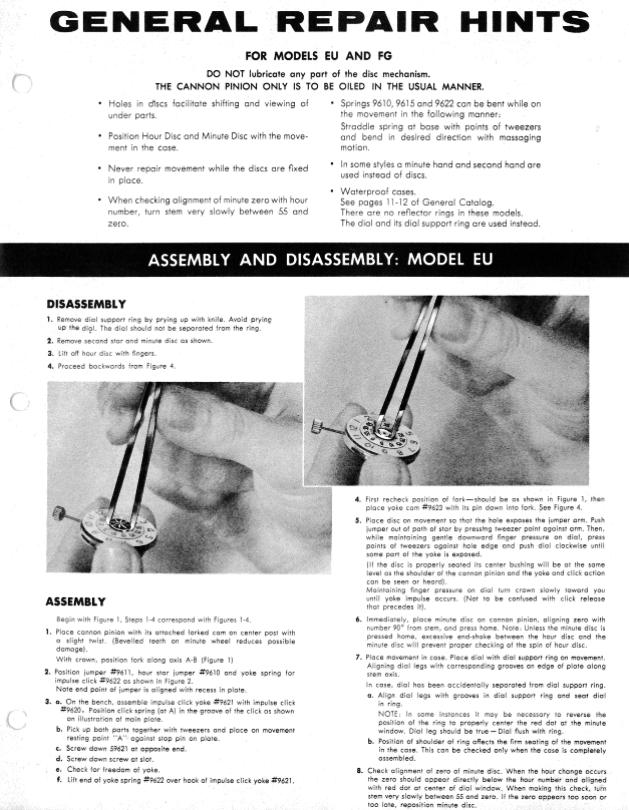BENRUS DIAL-O-RAMA DIRECT READ JUMP HOUR 1957
The Dial-o-rama is a cult item for all Jump hour collectors and is probably the most recognized of all direct readers. It was one of the first mechanical digitals that re-appeared in the late 1950's nearly 30 years after the launch of the early wristwatch jump hours like AS340. It was a direct competitor to Elgin Direct Readers and although the Benrus is far simpler and more reliable in technical terms the Elgins are worth much more probably due to the association with King Elvis. The Benrus is also dust and waterproof by encapsuling the caseback (with dome plexi crystal) in the outer bezel (chrome or GF). A special press-tool was used for this purpose but you can use any crystal press or hold the watch by the strap and push the crystal with your fingers. Pull out the crown with a split-stem and remove the movement from the caseback.
 Benrus didn't produce movements but used Swiss imports. The most common calibre is the FG25 but a scarce first generation EU25 movement can occasionally be found. The movement number is just an internal company symbol but it's much easier to source cheap parts knowing the base Swiss calibre. The Dial-O-Rama is derived from a Fontainemelon FHF72 and associated calibers with similar parts are FHF/ST 72, 73, 74, 96 and all their types 72-x, 73-x, 72x, 73x (date, no date, etc). Some gear train parts from 96-x might need some modifications because the pinions are slightly longer. Setting parts e.g. clutch are identical even if the top (signed) bridges are shaped differently (triangular shape in the Benrus). The same movement in very poor finish can be rarely found in West-End watches.
Benrus didn't produce movements but used Swiss imports. The most common calibre is the FG25 but a scarce first generation EU25 movement can occasionally be found. The movement number is just an internal company symbol but it's much easier to source cheap parts knowing the base Swiss calibre. The Dial-O-Rama is derived from a Fontainemelon FHF72 and associated calibers with similar parts are FHF/ST 72, 73, 74, 96 and all their types 72-x, 73-x, 72x, 73x (date, no date, etc). Some gear train parts from 96-x might need some modifications because the pinions are slightly longer. Setting parts e.g. clutch are identical even if the top (signed) bridges are shaped differently (triangular shape in the Benrus). The same movement in very poor finish can be rarely found in West-End watches.
The most common FG25 movement is very simple with just a few modifications of the base calibre. These include two springs, a copper-plated jumping wheel (called "impulse eccentric" #9613) and an additional "driving wheel" (#242) press fitted onto the cannon pinion. The rotating "impulse eccentric", moved by the cannon pinion, gradually lifts the top jump spring ("impulse click spring" #9615) which is quickly released after a full rotation. This causes the impulse eccentric to jump and a small pin on top of it kicks the copper plated star-shaped wheel ("hour star" #9600) press-fitted on the bottom side of the hour disc. A countering safety spring at the bottom ("hour star jumper" #9610) prevents the hour disc from jumping more than by one hour. Please read more details from an extremely rare technical bulletin available here.
 A very rare EU25 calibre was fitted to a few early Dial-o-rama's (pictured right and below). In dozens of Dial-o-rama's I have only ever encountered a few EU25 movements that are likely to be found in cases with low serial number of approx. 240.xxx-250.xxx. The EU25 is far more complicated and vulnerable to wear and shock and additionally the working principle is different as the hour disc jumps in the opposite direction! The cannon pinion is equipped with a fork (called "cam driver" #244) that drags a copper-plated jumping wheel ("yoke cam" #9623) by holding it by an exposed (punched) pin. It has the same shape as the "impulse eccentric" (#9613) in the FG25 but is neither screwed nor press-fitted to the movement. It is mounted on the cannon pinion and must remain loose only held in place by pressure from the hour disc.
A very rare EU25 calibre was fitted to a few early Dial-o-rama's (pictured right and below). In dozens of Dial-o-rama's I have only ever encountered a few EU25 movements that are likely to be found in cases with low serial number of approx. 240.xxx-250.xxx. The EU25 is far more complicated and vulnerable to wear and shock and additionally the working principle is different as the hour disc jumps in the opposite direction! The cannon pinion is equipped with a fork (called "cam driver" #244) that drags a copper-plated jumping wheel ("yoke cam" #9623) by holding it by an exposed (punched) pin. It has the same shape as the "impulse eccentric" (#9613) in the FG25 but is neither screwed nor press-fitted to the movement. It is mounted on the cannon pinion and must remain loose only held in place by pressure from the hour disc.
This jumping wheel gradually moves the large lever on the right ("yoke" #9621) until the lever stops at the large screw at 2 o'clock. The "impulse click" (#9620) fixed to the left side of the "yoke", travels along the unlocking side of one tooth of the "hour star" (#9600) press-fitted to the bottom of the hour disc. When "yoke" is driven back far enough by "yoke cam" for the "impulse click" to clear the tooth, the "click" under tension drops inward and faces impulse face of the "hour star" tooth. A moment later the rotating "yoke cam" gradually lifts and suddenly drops the "yoke" once it reaches the shallow end of the cam. Then the yoke's "impulse click" strikes the tooth in its path and advances the "hour star" to the next tooth. A safety-spring ("hour star jumper" #9610) prevents the hour disc from jumping more than by one hour.
Keywords: benrus jump hour, dialorama, dial-o-rama
Market value: 100-500$ (version, condition, mega rare box)




















